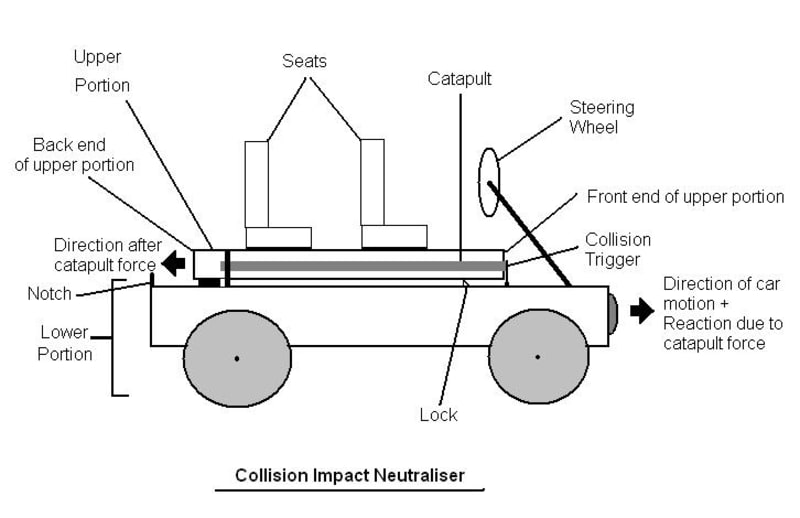Car Collision Energy Neutralizer
High speed is the biggest factor in deciding the impact extent of a car collision. High speed results in high kinetic energy which in turn results in greater collisions.
The idea here is to have some potential energy stored in the car (always) which will cancel some amount of the kinetic energy at the time of collision.
The car chassis is divided into two portions -
Upper portion - Comprising the seats which can slide over the lower portion.
Lower portion - The main base to which the car wheels and the steering + dashboard are attached (It has more inertia due to engine etc.)
Whenever a collision occurs, it triggers the catapult by releasing it.
The seats of the car (Upper portion) are attached to a catapult like formation which is pulled to high tension (It remains like this always i.e. even when the car is being driven). The catapult can be made of high strength rubber. When the collision occurs, the catapult is released and the upper portion (seats of the car) slides back towards the rear side i.e. in the direction opposite to the motion of the car.
Due to the backward motion of the seats of the car, the lower portion of the car is further accelerated forward (Newton's third law - To every action, there is an equal and opposite reaction). The effect is low due to heavier inertia of lower portion. This also widens the gap between the ‘steering wheel & dashboard’ and the driver (which is good for the driver's safety).
In the meantime, the airbag also comes up in between the driver and the steering wheel.
The backwards moving upper portion and the forward moving lower portion try to cancel each other. As soon as the front end of the upper portion moves back enough to slide past the lock, the upper portion moves slightly down (due to its weight) and gets locked. The lock stops the upper portion from moving forward. The small lock (as given in the diagram) blocks the upper portion and maintains the gap between driver and the steering wheel. Similarly, the notch at the rear edge of the lower portion prevents the back end of the upper portion from moving further backwards. So, the notch – lock combo works to keep the upper and lower portions from separation.
Overall, the potential energy stored in the pulled catapult gets converted (during collisions) into kinetic energy in the opposite direction which cancels out some of the kinetic energy of the impact. The stored potential energy neutralizes the kinetic energy ONLY for the upper portion (to which the seats are attached).
The equation can be written as -
High Kinetic Energy (Of impact) - Stored potential energy (Of catapulted seats) = Lower Kinetic Energy (Less severe collision for upper portion)
Like this entry?
-
About the Entrant
- Name:Shantanu Shekhar
- Type of entry:individual
- Software used for this entry:MS Paint, ASUS
- Patent status:none

